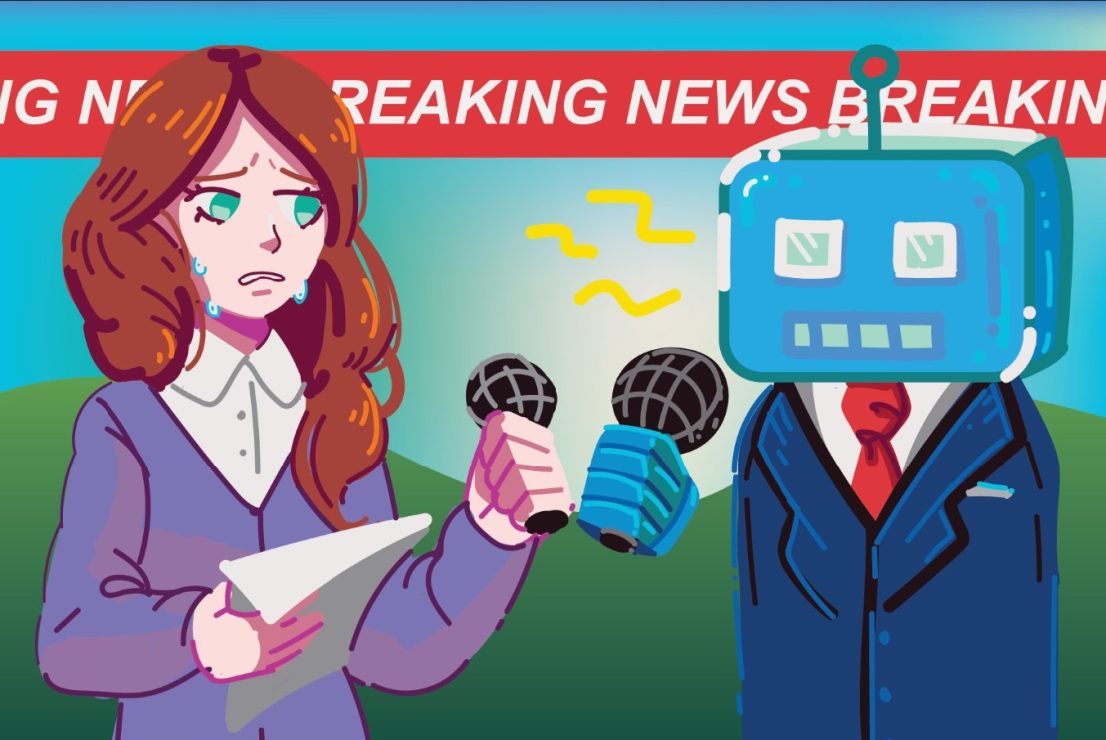The Globe and Mail’s newsroom memo made public is proof

Illustration by Sie Douglas-Fish.
On June 14, the Globe and Mail published their new policy on artificial intelligence (AI) in journalism.
The policy, which was initially a newsroom memo, announces the Globe’s regulations on the use of artificial intelligence: AI should not be used to produce new writing, nor to edit, and work (like photos, videos, or exemplary text) generated by AI should be clearly labeled as such.
Matt Frehner, the head of visual journalism at the Globe, begins the article with an italicized note, indicating the publication’s choice to move the newsroom memo into the public domain, to be shared with readers.
The note acknowledges “the promise of AI as a journalistic tool” as well as the threat to “truth, trust, and transparency,” which the Globe claims are their core tenets — as should, and do, most news outlets.
Truth, trust, and transparency are, indisputably, essential qualities of honest work in the age of war on journalism.
The newsroom memo was published to “provide context and clarity to Globe readers,” about the publication’s stance on AI.
While this is undoubtedly admirable, the policy’s public circulation indicates more than what Frehner is letting on.
By publishing their updated policy, the Globe is practicing transparency with their readers, but at the same time, doing something exponentially more groundbreaking. They are sounding a first-of-its-kind siren to their readership, suggesting that, as journalism adapts, so must its consumers.
“Any response from these tools should be treated with skepticism: it is unverified information, and AI is not concerned with truth in the same way we are as journalists,” Frehner writes.
A great emphasis is placed, throughout the memo, on the importance of being able to differentiate between AI-generated media and media created by a human being.
But the Globe can only do so much in terms of labeling AI-produced work, which will remain true as AI inevitably takes on a larger role in journalism. In order for the integrity of journalism as a vehicle for truth to remain intact, the majority of the onus to differentiate appropriately will fall to the reader.
As such, the siren sounds.
While journalists are occupationally preoccupied by truth in media, readers have never been responsible for critical consumption in the same way as they will have to be now, when identifying artificial versus human sources. Thus is the revolutionary nature of the Globe’s choice to implicate their readers in their AI policy by sharing it publicly.
For now, the Globe has expressed their opposition to generating news writing using AI, but the rapid development of AI promises that our newsroom relationship to it will be ever-evolving.
“ChatGPT and other tools like to impersonate the ‘human’ voice. Let’s guard against any ambiguity on the source of AI text,” says the Globe’s policy.
When considering what the coexistence of AI journalism and traditional journalism might look like in the future, the impersonation factor is key.
People crave authenticity — we have always been hungry for the real thing — and journalism in the AI age will reflect this.
If and when AI news writing coexists with human-written journalism, I suspect that a formula fatigue will set in for readers of AI-generated stories, and journalism — real journalism, written by way of human intelligence — will become novel in the same way that paperbacks possessed an attractive new glimmer after the introduction of the e-reader.
For this reason I am hopeful that when we look ahead, we are not looking toward the extinction of human-written journalism as AI progresses. Though, despite my hope, I am not convinced that this will be true.
There is no possible way to know what the future holds — we can only speculate. And as journalists, we can only revel in the familiarity of our current reality for the brief moment that it exists, before we must do our best to adapt, again.
My prediction? In time, as AI integrates itself into the modern newsroom and the issue of truth in journalism consequently becomes more pressing, we will look back on the Globe and Mail’s public statement and consider it a north star of journalistic integrity in the digital age and the genesis of a necessary symbiosis between journalist and reader.
Whether it is with pride or regret that we reflect on this pivotal moment will be determined by our next steps. So, for the love of truth, please read critically, and tread with care over journalism’s trembling terrain.








